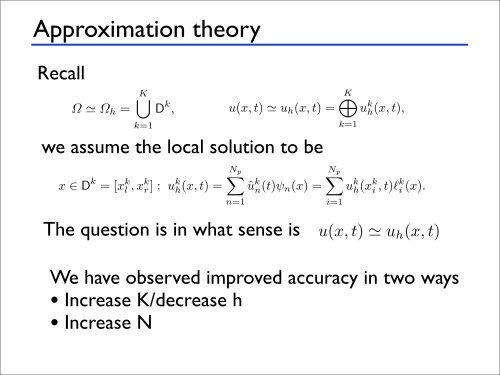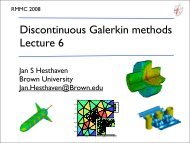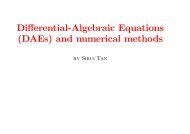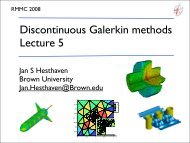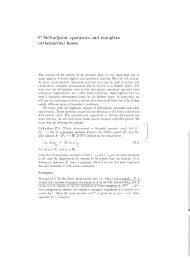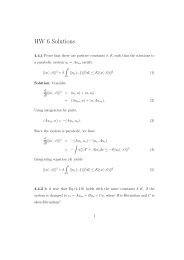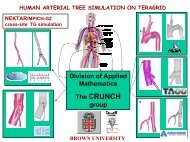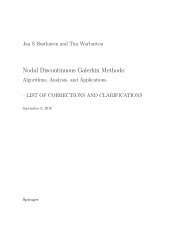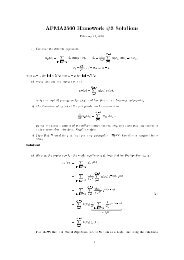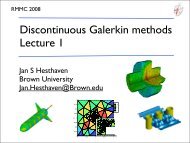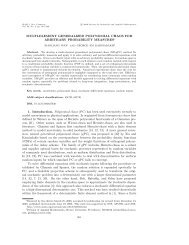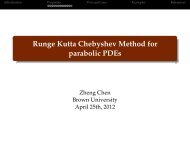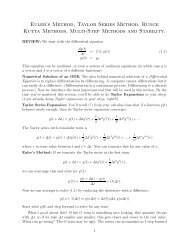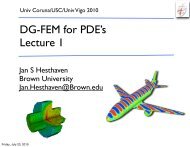Discontinuous Galerkin methods Lecture 3 - Brown University
Discontinuous Galerkin methods Lecture 3 - Brown University
Discontinuous Galerkin methods Lecture 3 - Brown University
Create successful ePaper yourself
Turn your PDF publications into a flip-book with our unique Google optimized e-Paper software.
Lagrange polynomial, ℓ<br />
Approximation theory<br />
k i (x). The connection between these two forms is through<br />
the expansion coefficients, ûk n. We return to a discussion of these choices in much m<br />
for now it suffices to assume that we have chosen one of these representations.<br />
The global solution u(x, t) is then assumed to be approximated by the piecew<br />
polynomial approximation uh(x, t),<br />
K<br />
u(x, t) uh(x, t) = u<br />
k=1<br />
k K<br />
, v) Ω,h = (u, v) k<br />
D , u<br />
k=1<br />
h(x, t),<br />
2 Ω,h =(u, u) Ω,h .<br />
cts that Ω is only approximated by the union of D k , that is<br />
K<br />
Ω Ωh = D<br />
k=1<br />
k K<br />
u(x, t) uh(x, t) = u<br />
k=1<br />
Recall<br />
,<br />
not distinguish we assume the twothe domains local unless solution needed. to be<br />
has local information as well as information from the neighong<br />
an intersection between two elements. Often we will refer<br />
ese intersections in an element as the trace of the element.<br />
e discuss here, we will have two or more solutions or boundthe<br />
same physical location along the trace of the element.<br />
k h(x k ,t).<br />
The careful reader will note that this notation is a bit careless, as we do not<br />
address what exactly happens at the overlapping interfaces. However, a more<br />
careful definition does not add anything essential at this point and we will use<br />
this notation to reflect that the global solution is obtained by combining the<br />
K local solutions as defined by the scheme.<br />
The local solutions are assumed to be of the form<br />
x ∈ D k =[x k l ,x k r]: u k Np <br />
h(x, t) = û<br />
n=1<br />
k Np <br />
n(t)ψn(x) = u<br />
i=1<br />
k h(x k i ,t)ℓ k Here, we have introduced two complementary expressions<br />
known as the modal form, we use a local polynomial basis<br />
be ψn(x) =x<br />
i (x).<br />
n−1 . In the alternative form, known as the n<br />
N + 1 local grid points, xk i ∈ Dk , and express the polynom<br />
Lagrange polynomial, ℓk i (x). The connection between thes<br />
the expansion coefficients, ûk n. We return to a discussion of<br />
for now it suffices to assume that we have chosen one of th<br />
The global solution u(x, t) is then assumed to be app<br />
polynomial approximation uh(x, t),<br />
K<br />
The question is in what sense is<br />
u(x, t) uh(x, t) =<br />
We have observed improved accuracy in two ways<br />
• Increase K/decrease h<br />
• Increase N<br />
k=1<br />
u


